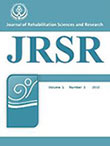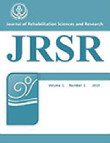فهرست مطالب

Journal of Rehabilitation Sciences and Research
Volume:5 Issue: 3, Sep 2018
- تاریخ انتشار: 1397/06/20
- تعداد عناوین: 5
-
-
Pages 63-67BackgroundChronic otitis media with effusion (CME) primarily affects children. Temporary auditory deprivation is a serious complication of this disease and can result in auditory processing disorder, as demonstrated in past studies. The objective of the current study was to investigate the effects of CME duration on binaural processing and amblyaudia.MethodsNinety-four children were examined, including 48 children (29 girls=60%) with different CME durations (from 3 months to more than 9 months) and 46 children (34 girls=73%) with no history of CME or a duration of less than 3 months CME. Persian versions of the dichotic digits and dichotic rhyme tests were applied.ResultsSignificant differences between the groups (P<0.001) in dichotic digits difference (DDD) and dichotic rhyme difference (DRD) in free recall conditions were identified. With longer durations of CME, the DDD and DRD average scores were increased in the CME positive group, and the probability of amblyaudia was also enhanced.ConclusionA history of CME and the long-term auditory deprivation resulting from it in early childhood can increase the risk of amblyaudia.Keywords: Dichotic digit test, Dichotic rhyme test, Auditory processing disorder, Amblyaudia, Free recall attention
-
Pages 68-73BackgroundHemodialysis patients with end-stage renal disease (ESR) have lower physical, emotional, and cognitive functions than healthy people of the same age due to their inactive lifestyles and treatment approaches. This study aimed to investigate the effects of selected core stability exercises on the dialysis quality and muscular strength of male hemodialysis patients.MethodsIn this quasi–experimental study, 30 male hemodialysis patients (age: 62.24±6.51 years; history of dialysis: 9.4±18.44 months) were selected by convenience sampling and assigned into experimental (n=15) and control (n=15) groups. The quality of dialysis and muscular strength of the subjects were assessed by blood sampling before and after dialysis and 5× sit-to-stand tests, respectively. A core stability exercise program was performed for 6 weeks, 3 sessions per week, 45 minute per session.ResultsData analysis showed that there was no significant difference in the quality of dialysis between the experimental and control groups (P=0.485), but a significant difference was observed in muscular strength between the two groups (P=0.001). Exercise has a significant effect on the variable.ConclusionBased on the results of this study, core stability exercises can be recommended to male hemodialysis patients as a safe and practical strategy for improving their muscular strength and quality of life.Keywords: Core Stability, Hemodialysis, Dialysis Quality
-
Pages 74-80BackgroundShoulder joint function and the athletic performance of overhead athletes are influenced by scapular dyskinesis (SD) due to its high prevalence among these athletes and the motor interaction between the scapula and the arm. The present study investigated the prediction of SD through the electromyographic indices of scapulothoracic muscles in female overhead athletes.MethodsThe present descriptive-correlational study was carried out on 60 female volleyball, handball, basketball, and badminton athletes. The lateral scapular slide test was used to examine their SD. The required electromyography and electrogoniometry data was recorded simultaneously to measure the activity and onset time of scapulothoracic muscles, including upper trapezius (UT), lower trapezius (LT), and serratus anterior (SA). The collected data was analyzed using Spearman correlation and multiple regression tests.ResultsSignificant correlations were found between all electromyographic variables and SD (P<0.01). The regression effects of all predictive variables on SD were significant (P=0.001). In terms of predictive power, UT/SA co-contraction (β=0.765), UT/LT co-contraction (β=0.716), LT onset time (β=0.672), LT activity (β=0.612), and SA onset time (β=0.576) had the highest regression effects on SD, respectively. The analysis of the study model showed that there was a strong correlation (r=0.694) between the predictive variables and SD and that the independent variables predicted 48% of the variance.ConclusionThe presence of imbalance in the scapulothoracic muscles of overhead athletes with SD indicates that athletes should be monitored by coaches, physiotherapists, and physicians for SD screening. It is also necessary to carry out prospective studies to examine and explore other variables related to SD.Keywords: Electromyography, Muscle onset time, Overhead athletes, Scapular dyskinesis, Scapulothoracic muscles
-
Pages 81-85BackgroundDecreased lumbar spine control may be associated with early and/ or excessive lumbopelvic motion with trunk and lower extremity movements during functional and daily activities. This study investigated differences in lumbopelvic movement patterns in people with and without low back pain (LBP) during a stair descending (SD) task.MethodsA total of 36 subjects, 18 females with non-specific chronic low back pain (NSCLBP) and 18 healthy females, participated in this study. A threedimensional motion capture system was used to record kinematics during the SD task.ResultsThe results showed that in the LBP group, the start-time of the lumbar muscles occurred early in the movement (P=0.015). Additionally, subjects with LBP showed excessive lumbar spine and pelvic movement during the SD task (P<0.05).ConclusionLBP patients make early and excessive lumbopelvic movements during a SD task, and this can be an important factor contributing to the development or persistence of their LBP problem. This finding should be considered by clinicians when evaluating functional tasks as part of movementbased examinations and rehabilitation programs for people with LBP.Keywords: Low back pain, Lumbopelvic movement, Kinematics, Stair descending
-
Pages 86-92BackgroundTime perception is considered as an important subject in cognitive psychology, which is essential for our understanding regarding brain mechanisms underlying human cognition and disabilities. Deficits in time perception have been found in people with both attention-deficit/hyperactivity disorder (ADHD), dyslexia, Parkinson’s and Alzheimer’s disease. The present study aimed at developing and evaluating the Time Perception Software with a sample including 152 Iranian students.MethodsThe computerized time perception task was designed based on time estimation, reproduction, production and time comparison method. In order to verify the reliability of the task, 30 students which were participated in the test sample repeated the test after one month. The content and construct validity were used in order to examine the validity of the task. The construct validity of the time perception task was verified by analyzing the confirmatory factor analysis using the Amos 24 software.ResultsIn the modified model, the comparison factor was eliminated (CFI=0.965). The highest correlation was observed in the time estimation of 11 seconds with a correlation coefficient which was equal to 0.935 (P=0.001), while the lowest correlation coefficient was observed in the time production of 17 seconds with the correlation coefficient which was equal to 0.679 (P=0.001). The internal consistency of the task indicated that the time perception task had a near-optimal validity and its reliability was at the optimal level with the Cronbach’s alpha which was equal to 0.67.ConclusionIn order to conclude, The Time Perception Software appeared to be reliable and valid for assessing and measuring time perception in the Iranian students. This software can be used in future research investigations.Keywords: Time estimation test, Time reproduction, Time production, Time comparison


